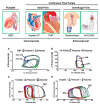A Holistic View of Advanced Heart Failure
- PMID: 36143336
- PMCID: PMC9501910
- DOI: 10.3390/life12091298
A Holistic View of Advanced Heart Failure
Abstract
Advanced heart failure (HF) may occur at any level of left ventricular (LV) ejection fraction (LVEF). The latter, which is widely utilized for the evaluation of LV systolic performance and treatment guidance of HF patients, is heavily influenced by LV size and geometry. As the accurate evaluation of ventricular systolic function and size is crucial in patients with advanced HF, the LVEF should be supplemented or even replaced by more specific indices of LV function such as the systolic strain and cardiac power output and size such as the LV diastolic diameters and volumes. Conventional treatment (cause eradication, medications, devices) is often poorly tolerated and fails and advanced treatment (mechanical circulatory support [MCS], heart transplantation [HTx]) is required. The effectiveness of MCS is heavily dependent on heart size, whereas HTx which is effective in the vast majority of the cases is limited by the small donor pool. Expanding the MCS indications to include patients with small ventricles as well as the HTx donor pool are major challenges in the management of advanced HF.
Keywords: advanced heart failure; heart transplantation; mechanical circulatory support; shock.
Conflict of interest statement
The authors declare no conflict of interest.
Figures






Similar articles
-
Heart transplantation from donors with left ventricular ejection fraction under forty percent.Clin Transplant. 2021 Jul;35(7):e14341. doi: 10.1111/ctr.14341. Epub 2021 May 25. Clin Transplant. 2021. PMID: 33949006
-
Biventricular pacing (cardiac resynchronization therapy): an evidence-based analysis.Ont Health Technol Assess Ser. 2005;5(13):1-60. Epub 2005 Sep 1. Ont Health Technol Assess Ser. 2005. PMID: 23074464 Free PMC article.
-
Acute Hemodynamic Effects of Intra-aortic Balloon Counterpulsation Pumps in Advanced Heart Failure.J Card Fail. 2017 Aug;23(8):606-614. doi: 10.1016/j.cardfail.2017.05.015. Epub 2017 May 26. J Card Fail. 2017. PMID: 28554716
-
Left ventricular ejection fraction as therapeutic target: is it the ideal marker?Heart Fail Rev. 2017 Nov;22(6):641-655. doi: 10.1007/s10741-017-9624-5. Heart Fail Rev. 2017. PMID: 28601914 Review.
-
Mechanical circulatory support devices in advanced heart failure: 2020 and beyond.Prog Cardiovasc Dis. 2020 Sep-Oct;63(5):630-639. doi: 10.1016/j.pcad.2020.09.003. Epub 2020 Sep 21. Prog Cardiovasc Dis. 2020. PMID: 32971112 Review.
Cited by
-
Molecular Diagnostics in Heart Failure: From Biomarkers to Personalized Medicine.Diagnostics (Basel). 2025 Jul 17;15(14):1807. doi: 10.3390/diagnostics15141807. Diagnostics (Basel). 2025. PMID: 40722556 Free PMC article. Review.
-
Targeting Sodium in Heart Failure.J Pers Med. 2024 Oct 17;14(10):1064. doi: 10.3390/jpm14101064. J Pers Med. 2024. PMID: 39452570 Free PMC article. Review.
-
The Neurohormonal Overactivity Syndrome in Heart Failure.Life (Basel). 2023 Jan 16;13(1):250. doi: 10.3390/life13010250. Life (Basel). 2023. PMID: 36676199 Free PMC article.
-
Aortic pulse wave analysis and functional capacity of heart transplantation candidates: a pilot study.Sci Rep. 2024 May 7;14(1):10504. doi: 10.1038/s41598-024-61152-w. Sci Rep. 2024. PMID: 38714788 Free PMC article.
References
-
- Solomon S.D., Dobson J., Pocock S., Skali H., Mcmurray J., Granger C.B., Yusuf S., Swedberg K., Young J.B., Michelson E.L., et al. Influence of nonfatal hospitalization for heart failure on subsequent mortality in patients with chronic heart failure. Circulation. 2007;116:1482–1487. doi: 10.1161/CIRCULATIONAHA.107.696906. - DOI - PubMed
-
- Ammar K.A., Jacobsen S.J., Mahoney D.W., Kors J.A., Redfield M.M., Burnett J.C., Jr., Rodeheffer R.J. Prevalence and prognostic significance of heart failure stages: Application of the American College of Cardiology/American Heart Association heart failure staging criteria in the community. Circulation. 2007;115:1563–1570. doi: 10.1161/CIRCULATIONAHA.106.666818. - DOI - PubMed
-
- Fang J.C., Ewald G.A., Allen L.A., Butler J., Canary C.A.W., Colvin-Adams M., Dickinson M.G., Levy P., Stough W.G., Sweitzer N.K., et al. Advanced (stage D) heart failure: A statement from the Heart Failure Society of America Guidelines Committee. J. Card. Fail. 2015;21:519–534. doi: 10.1016/j.cardfail.2015.04.013. - DOI - PubMed
-
- Crespo-Leiro M.G., Metra M., Lund L.H., Milicic D., Costanzo M.R., Filippatos G., Gustafsson F., Tsui S., Barge-Caballero E., De Jonge N., et al. Advanced heart failure: A position statement of the Heart Failure Association of the European Society of Cardiology. Eur. J. Heart Fail. 2018;20:1505–1535. doi: 10.1002/ejhf.1236. - DOI - PubMed
Publication types
LinkOut - more resources
Full Text Sources
Research Materials
Miscellaneous

